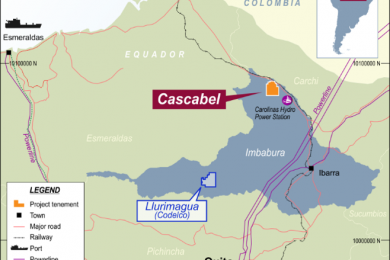An Australian company says its flagship Tier 1 copper gold discovery in Ecuador could potentially deliver between 2.5% and 3% of that country’s GDP once mining commences. AIM-listed SolGold – presenting on the second day of the sixth Paydirt Latin America Downunder conference in Perth – also detailed a major ramp-up in on-site work over the next 18 months to bring its Cascabel copper gold porphyry discovery closer to final investment decisions.
The deposit is located on the northern Andean copper belt with A$43 million already spent to date to continue to define its open-ended mineralisation. The project’s upside has attracted Australian gold miner Newcrest onto the SolGold register, with a10% stake, and TSX listed Guyana Goldfields.
SolGold Business Development Manager, Ms Pru Maclean, told conference delegates today that some 95,000 m of drilling would be undertaken between now and the end of 2018 at Cascabel with a dual listing on the TSX and moving from the AIM market to the London main board.
“We are increasing rig numbers on site from three to 10 as well as initiating magnetics, IP and metallurgical work, with a resource for the Alpala deposit hoped by the end of 2017,” Maclean said.
“It is one of the most significant discoveries in the past 10 years and with the new pro-mining stance in Ecuador replacing its oil based GDP, we believe the Cascabel project can contribute strongly to that country’s economy.”
Maclean said Cascabel’s development would parallel what she saw as a rising copper demand.
“Global urbanisation is irrevocably driving copper demand skyward at a time that global resource inventory grades for the commodity are falling,” she said. “In 1990, these grades averaged 1.6% Cu for underground inventories but this had eased to 1.1% by 2015.
“Copper’s supply growth is being constrained by geopolitics and technology and profitable production is falling, and we note too that while copper exploration spend is on the rise, the number of big new discoveries is limited.”
Cascabel is in good company with the Andean copper belt producing around 48% of the world’s copper output.
“This is a deposit with high grades, predictable geology and in a country with a mature regulatory and fiscal environment,” Maclean explained.
The project has yielded another 15 possible porphyry centres of which nine are considered high priority to the company. Alpala is the only target drilled to date yielding seven intersections of over 1 km of continuous mineralisation.
The site is well supported by nearby transport and export infrastructure, abundant water and inexpensive hydro power source.
SolGold is continuing to apply for new ground in Ecuador and will apply the same blueprint that found the Alpala deposit.
Australian miners in general are turning their attention to opportunities in a revitalised Ecuadorean resources sector. The country has just sworn in a new President and is bringing to an end a decade of suffocation and investment disincentive in the sector.
Fortescue, GreenRock, Odin Mining, Carnegie Ridge, Proyectmin and Megarmi are early Australian ‘Expression of Interest’ starters in the new Ecuadorean mining game – refreshed after an overall of its mining regime and regulations.
Addressing the second day today of the conference last week, Spurrier Group/Think Tank economist, Walter Spurrier, said large mining companies are now finding the revitalised mining framework sufficiently attractive enough to enter the country’s resources sector.
“Last May when the bid process was opened for new mining concessions, there were 300 applications,” Spurrier said. “By comparison, until then, no mining concessions had been granted since 2007 as the country’s administration preferred to bask in and favour its oil riches until an economic rethink was forced on them in the subsequent 2014 oil price collapse.
“What this has generated is an expectation now of some $4 billion in new mining investment in Ecuador through to 2020. The country remains lightly explored for metal deposits.”
Outgoing President Rafael Correa who came to power in 2007, imposed a mining ban and discouraging tax regimes, resulting in new in-country discoveries made by Canadian miners, languishing and a flight of exploration companies.
“The need for more business friendly legislation, particularly in the mining game, has sunk in for the administration in recent years, moving from mining terms extremely attractive to government but for which there were no takers for a decade, to current new terms that are sufficient to bring overseas entities into Ecuador’s mining upside,” Spurrier said.
“Some of these welcome changes are in key areas such as regulations around windfall profits, transfer of mining rights, income tax withholding, and mining royalties advance payments.
“So, we have a regime and new mining frameworks that are robust enough to see the mining sector now become one of the three pillars of the economy in Ecuador.”
The Australian companies including Fortescue were granted deeds to concessions in Ecuador’s northern region, covering Esmeraldas, Carchi, Imbabura and Sucumbíos.










